Abstract
Active research has been conducted in recent years on heating construction materials using nanotechnology to solve the problem of black ice, which is often the cause of frequent traffic accidents during winter. To determine the optimal heating construction material, this study analyzed the heating performance of carbon-based nanomaterials, such as multiwalled carbon nanotubes (MWCNTs), conductive carbon black (CB), and graphene nanoplatelets (GNPs). Heating and electrical resistance experiments were performed based on the parameters of the selected nanomaterial, concentrations, and curing days to analyze the heating efficiency. Results showed that compared with OPC, the heating performances of GNP, CB, and MWCNT cementitious composites improved by 132, 171, and 224 times, respectively. Furthermore, the MWCNT cementitious composite exhibited excellent heating efficiency.
1. Introduction
Frequent traffic accidents occur worldwide during winters owing to black ice, an invisible thin layer of ice formed on roads, which makes roads icy. To solve the issue of black ice on bridges or tunnel entrances, which is caused by abrupt temperature decreases, several researchers have studied the heating performances of nanocementitious composites by mixing carbon-based nanomaterials with cement [1,2,3,4,5,6,7,8].
First, the heating performance was improved when carbon nanotubes (CNTs) with excellent thermal performance were combined with cement before their placements on structures [2,9,10,11]. Makar et al. [10] combined cement pastes with CNTs to study the binding characteristics, including flexural and breaking strengths, and conducted image analyses using scanning electron microscopy (SEM) and strength tests. Results showed strong binding between the cement paste and CNTs, and verified their applicability to structures that require high strength, and emphasized the need to utilize the electrical and thermal properties of CNTs. Lee et al. [12] fabricated a nanocementitious composite by performing heating curing, and showed that the compressive strength of the composite with a concentration of 1 wt% improved by 23% compared with the control specification. Manzur et al. [13] studied the compressive strength of multiwalled carbon nanotubes (MWCNT) cementitious composites as a function of their sizes. The compressive strength of the MWCNT cementitious composite increased because the microstructures were formed more efficiently in the specimen. Jung et al. [11] used the dispersion method to combine ultrahigh-performance concrete (UHPC) with CNTs, and analyzed the mechanical properties and electromagnetic shielding effects. Research results showed that the mechanical properties and electrical conductivity improved owing to the dispersed CNTs. Kim et al. [12] analyzed the electrical resistance and heating characteristics of cementitious composite mixed with CNTs. Research results showed that the heating performance improved as the amount of CNT increased, and the electrical resistance increased as the input voltage increased. However, an accurate correlation between the heating performance and strength needs to be determined by considering the changes in durability owing to thermal expansion and heating of cementitious composite mixed with CNTs. Kim et al. [14] analyzed the CNT dispersion and void characteristics to assess the electrical performance of cementitious composite mixed with CNT. Research results showed that CNT dispersion occurred effectively, and the void decreased when silica fume was added to the mixture of the cementitious composite and CNT; these changes increased the electrical conductivity. Li et al. [15] examined the mechanical properties and microstructure of cementitious composite mixed with MWCNT based on compressive and flexural strength tests and SEM image analysis. Research results showed that the mechanical performance of the mixture improved owing to the binding achieved via interfacial interactions and the micropore sizes. Xu et al. [16] investigated the compressive strength and microstructure of a cementitious composite mixed with MWCNT. Compressive strength tests and SEM image analysis were performed by effectively dispersing MWCNT in water using a surfactant. Results showed that the compressive strength of cementitious composite increased as the MWCNT-to-cement-weight ratio increased. Furthermore, the SEM image analysis results showed that MWCNT and cement hydration products were connected overall, and the size of the voids within cementitious composite decreased. Numerous studies have been conducted using carbon black (CB) as an admixture material owing to its excellent adsorption, heat-resistance, and fire-resistance characteristics. Monteiro et al. [17] studied the electrical properties of a cementitious composite mixed with CB, and observed that the resistance decreased and compressive strength increased as the CB content increased. Li et al. [18] analyzed the effects of compressive deformation on electrical resistance of a cementitious composite mixed with CB. Results showed that the electrical resistance and compressive deformation of cementitious composite mixed with CB exhibited a linear relationship, making CB a promising material for developing deformation sensors used in concrete structures. Monteriso et al. [19] studied the electrical and mechanical properties of a cement-based composite, which contained different amounts of CB and its response when subjected to a compressive load. Increments of compressive strengths were observed for the mortar sample that contained a 4% CB aggregate volume compared with the sample without carbon. Ding et al. [20] examined the mechanical and electrical properties of cementitious composites mixed with CB and carbon fiber (CF). Mechanical properties, such as load, deformation, and stress of the concrete beams were analyzed by considering the CB and CF contents as parameters. Simultaneously, the degrees of damage before and after cracking attributed to the changes in electrical resistance were analyzed. Results showed that the compressive strength increased as the content of CB and CF increased, and CB significantly impacted the flexural strength. Furthermore, several studies have been conducted with the use of graphene nanoplatelet (GNP) as an admixture, based on considerations of its capacity to improve tensile strength. Farooq et al. [21] studied the performance of cementitious composite mixed with CNT and GNP. SEM image analysis results showed that greater amounts of cement hydration products were generated while pores became finer and smaller. Additionally, the compressive strength of the mixture improved. Tao et al. [22] investigated the cement hydration products within cementitious composite mixed with CNT and GNP. Results showed that CNT and GNP did not have a noticeable effect on the cement hydration reaction, whereas the pores became finer and the bond products formed a porous structure owing to the dispersion and binding of CNT and GNP. Le et al. [23] analyzed the utilization of GNP in a cementitious composite for quantifying the scope of structural damage. Cementitious composite became a conductive object when a sufficient amount of GNP was mixed. Results showed that while a conductive object is significantly affected by the water content, GNP concentrations above a threshold value are unaffected by the water content; thus, GNP can be considered reliable as a damage-detection material. Sedaghat el al. [24] studied the heating properties and microstructure of cementitious composite mixed with GNP. Results showed that the diffusivity and electrical conductivity increased when the GNP content increased, and the thermal properties of cementitious composite mixed with GNP improved, which enhanced durability and decreased the early thermal cracking of concrete structures. Silva et al. [25] investigated the compressive strength for mortars with different multilayer graphene (MLG) nanoparticle dosages as a function of time, and the relative change in relation to the sample without MLG. An increase in compressive strength was observed for all samples prepared with MLG addition because MLG insertion yielded specimen microstructures with fewer defects. Wang et al. [26] studied the mechanical behavior of a cementitious composite mixed with evenly distributed GNP, and found that the flexural and compressive strengths of cementitious composite increased when an appropriate concentration of GNP was mixed.
This study aims to analyze a composite with the maximum heating efficiency by mixing carbon-based materials with cement to solve the issue of black ice during winter. Cementitious composites mixed with carbon-based nanomaterials are referred to as nanocementitious composites, and the evaluated parameters included type, concentration of the carbon-based nanomaterials, and curing days. Heating experiments were conducted for efficiency analysis to analyze the performance, and an experiment was conducted on electrical resistance. In addition, field-emission scanning electron microscopy (FE-SEM) was used to examine the internal structures of the nanocementitious composites fabricated in this study. Detailed research was conducted on the nanomaterial heating elements. This study analyzes a nanomaterial with an optimal heating efficiency by comparing three different types of carbon-based nanomaterials.
2. Experimental Program
Heating and electrical resistance experiments were conducted to analyze the heating efficiency of nanocementitious composites mixed with nanomaterials. Table 1 summarize the properties of nanomaterials mixed with cementitious composites, respectively. The parameters considered for the heating experiment of the nanocementitious composites were type, mixed concentration, and curing days. Three types of nanomaterials, namely, MWCNT, CB, and GNP (by Ditto Co., Ltd, Seoul, Republic of Korea) were analyzed, wherein the mixed concentrations of these nanomaterials were 0.25 wt%, 0.5 wt%, and 1.0 wt% with respect to the cement weight. The curing days were set to 7 and 28 d.

Table 1.
Properties of the nanomaterials (by Ditto Co., Ltd., Seoul, Korea).
The nomenclature of nanocementitious composites includes the type, mixed concentration, and curing days of a nanomaterial. “OPC”, “GNP”, “CB” and “MW” refer to ordinary Portland cement mortars without MWCNTs, graphene nanoplatelets, conductive carbon black, and MWCNTs, respectively, where the first and second characters indicate the type of nanomaterial and mixed concentration, respectively. The symbol “1.0” indicates that the mixed concentration of a nanomaterial is 1.0 wt% with respect to cement. The third character indicates the curing days, and “7D” indicates seven days of curing.
Additionally, a heating experiment was conducted to analyze the heating performances of nanocementitious composites mixed with nanomaterials. Heating performance was analyzed by fabricating three cementitious composites for each parameter, and determined the mean value of the temperature variations. Furthermore, the electrical resistance was analyzed by performing a test using an electrical resistance test for cementitious composites fabricated for each parameter.
Figure 1 shows a heating cement composite of the nanocementitious composites. Considering the standards for heating experiment of nanocementitious composites are not specified in Korea or internationally, the specimens were fabricated with dimensions 50 × 50 × 50 mm3 depending on the compressive strength test standards of cement mortar in ASTM C 109 [2,6,8,9,27,28].
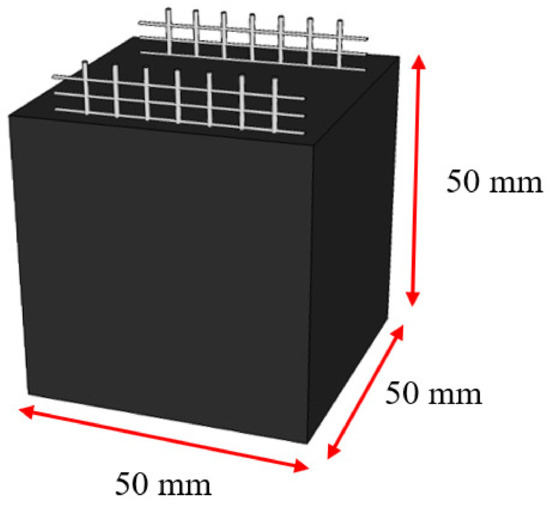
Figure 1.
Schematic of a nanocementitious composite.
Type 1 Portland cement and sand described in the KS L ISO 679 standard were used to fabricate the nanocementitious composites [3,29,30]. An aqueous solution (≥99.9% purity) was used to secure the dispersibility characteristics of MWCNT, CB, and GNP. The aqueous solutions were dispersed for 8 h in polyacrylic acid using 22 kHz ultrasonic waves [2,3,8,30]. A stainless material was used for electrodes to supply voltage to the nanocementitious composites. Size of stainless steel mesh is 40 mm × 80 mm and 2 pieces of mesh are used for each composites. The temperatures at the center of the nanocementitious composites were measured with the use of a thermocouple.
The water-to-cement ratio of the nanocementitious composites was found to be 0.5, whereas the weight ratio of the aqueous solution to cement to standard sand was 1:2:5 (40 g:80 g:200 g). Figure 2 shows the fabrication process of the nanocementitious composites. First, the nanomaterial aqueous solution, cement, and standard sand were measured according to the mix design (Figure 2a), and cement and standard sand were dry mixed for 2 min to secure material homogeneity, as shown in Figure 2b. As shown in Figure 2c, the aqueous nanomaterial solution was mixed with dry-mixed cement and standard sand for 3 min. The mixed nanocementitious composites were placed in three layers in the mold, and each layer was compacted 30 times (Figure 2d). Subsequently, two stainless steel meshes were inserted in the nanocementitious composites at 20 mm intervals for supplying voltage (Figure 2e). Lastly, a thermocouple was inserted at a depth of 25 mm in the center parts of the nanocementitious composites to measure the internal temperature during the heating experiment, as shown in Figure 2f. In this study, three specimens were fabricated per parameter by repeating the process described in Figure 2. The completed specimens were cured in controlled conditions, at temperatures of 23 ± 2 °C, and humidities of the order of 20%. After 24 h of curing, the nanocementitious composites underwent 7 and 28 d of dry curing according to the parameters.
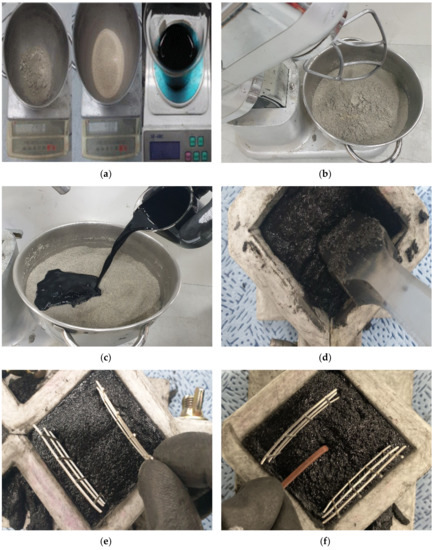
Figure 2.
Fabrication processes associated with the tested specimens. (a) Measuring materials; (b) Dry mixing (2 min); (c) Nanosolution mixing (3 min); (d) Compaction; (e) Insert stainless steel mesh; (f) Insert thermocouple.
The heating experiment of the nanocementitious composites was performed by supplying a certain voltage for the same amount of time. Figure 3a shows the setup for the heating experiment. A direct current power supply (power supply, EX-200) was used to provide voltages of 10 V, 20 V, 30 V, and 60 V for 1 h each. Voltage was supplied on insulating rubber plates by connecting the positive (+) and negative (−) electrodes to stainless steel meshes of the nanocementitious composites. The internal temperature of nanocementitious material, which increased owing to voltage, was measured by connecting the thermocouple installed during the experimental setup to a data logger (data logger, TDS-303). Electrical resistance experiment was conducted using a digital multimeter (Keithley 2701), as shown in Figure 3b. The (+), (−) electrodes of a digital multimeter were connected to the stainless steel meshes installed on the nanocementitious composites, and the measurements were conducted until the resistance converged to a certain value. To analyze the internal structure of the nanocementitious composites, accelerated electron beams were irradiated onto the specimens using the field emission SEM (FE-SEM) electron gun (LEO SUPRA 55), and signals such as secondary electrons and X-rays generated on the surface, were detected to image the internal structure.
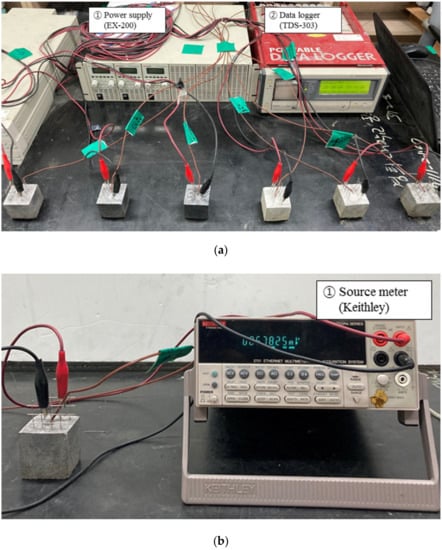
Figure 3.
Test setup: (a) Heating performance test, (b) Resistance test.
3. Experimental Results
Figure 4 shows the temperature variation of the nanocementitious composites after 7 d of curing. The temperature variation of OPC-7D, which is the control group, was found to be 0.1 °C when the supply voltage was 10 V. The temperature variations of GNP cementitious composites were 0.3 °C, 0.5 °C, and 1.0 °C at the mixed concentrations of 0.25 wt%, 0.5 wt%, and 1.0 wt%, respectively. The temperature variations of CB cementitious composites were 0.3 °C, 0.6 °C, and 1.4 °C at the respective mixed concentrations. The temperature variations of MWCNT cementitious composites were 0.4 °C, 1.0 °C, and 3.8 °C at the respective mixed concentrations. The largest temperature variation was observed in MW-1.0-7D, which was 3.7 °C higher than the control group (OPC). The temperature variation of OPC-7D was 0.1 °C when the supply voltage was 20 V. The temperature variations of GNP-mixed cementitious composites were 0.8 °C, 1.4 °C, and 4.2 °C at the mixed concentrations of 0.25 wt%, 0.5 wt%, and 1.0 wt%, respectively, whereas those of CB-mixed cementitious composites were 1.0 °C, 1.8 °C, and 6.2 °C, respectively. The temperature variations of MWCNT-mixed cementitious composites were 1.2 °C, 2.1 °C, and 7.8 °C. The maximum heating value of cementitious composites with 1.0 wt% of MWCNT was 6.1 °C higher than that of OPC. The temperature variation of OPC was 0.2 °C when the supply voltage was 30 V. The temperature variations of GNP-0.25-7D, GNP-0.5-7D, and GNP-1.0-7D were 1.5 °C, 3.1 °C, and 13.3 °C, respectively. The temperatures of CB-mixed cementitious composites were 1.7 °C, 3.2 °C, and 14.8 °C for very mixed concentration. The temperatures of MWCNT-mixed composites were 2.1 °C, 4.5 °C, and 31.9 °C at mixed concentrations of 0.25 wt%, 0.5 wt%, and 1.0 wt%, respectively. The maximum heating value was observed in MW-1.0-7D, and was 31.7 °C higher than that of OPC-7D. The temperature variation of the OPC-7D cementitious composite was 0.3 °C when the supply voltage was 60 V. The temperature variations of GNP-mixed cementitious composites were 4.3 °C, 18.5 °C, and 40 °C at the mixed concentrations of 0.25 wt%, 0.5 wt%, and 1.0 wt%, respectively. The temperatures of CB-mixed cementitious composites were 4.9 °C, 21.8 °C, and 51.7 °C. The temperatures of MW-0.25-7D, MW-0.5-7D, and MW-1.0-7D were 5.1 °C, 24.1 °C, and 67.5 °C, respectively. The largest temperature variation was observed in MW-1.0-7D, and was 67.2 °C higher than that of the OPC. When the heating performance of the nanocementitious composites cured for 7 d was analyzed, it was observed that the current flowing in composites increased as the supplied voltage increased; this improved the heating value of the cementitious composites. When the same type of nanomaterials was mixed in the cementitious composites, the heating value increased as the mixed concentration of nanomaterials increased. Nanomaterials form a network on which electrons can move within cementitious composites. Accordingly, as the mixed concentration of nanomaterials increased, multiple networks formed within the cementitious composites, and the heating value increased as the current flowing in cementitious composites increased. The heating performance was maximized at 40 °C for GNP-mixed cementitious composites, at 51.7 °C for CB-mixed cementitious composites, and at 67.5 °C for MWCNT-mixed cementitious composites.
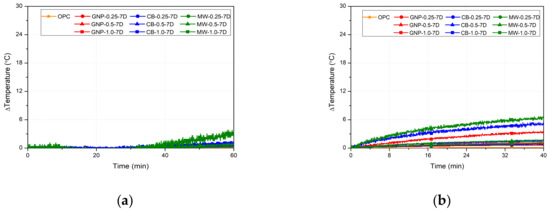
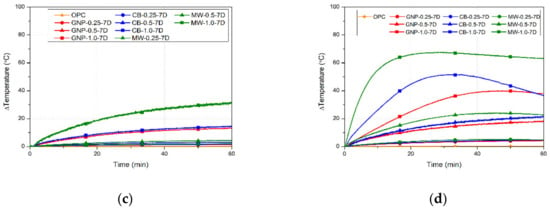
Figure 4.
Temperature variation plots of the nanocementitious composites at 7 d at different voltages: (a) 10 V; (b) 20 V; (c) 30 V; (d) 60 V.
Figure 5 shows the temperature variation of nanocementitious composites after 28 d of curing. The temperature variation of OPC-28D was insignificant at 0.1 °C when the supply voltage was 10 V. The temperature variations of GNP-mixed cementitious composites were 0.2 °C, 0.3 °C, and 0.7 °C when the mixed concentrations were 0.25 wt%, 0.5 wt%, and 1.0 wt%, respectively. The temperature variations of CB-mixed cementitious composites were 0.2 °C, 0.4 °C, and 1.0 °C when the mixed concentrations were 0.25 wt%, 0.5 wt%, and 1.0 wt%, respectively. The temperature variations of MW-0.25-28D, MW-0.5-28D, and MW-1.0-28D were 0.2 °C, 0.9 °C, and 2.1 °C, respectively. The largest temperature variation occurred in the case of the cementitious composite mixed with 1.0 wt% MWCNT. The temperature variation of OPC-28D was 0.1 °C when the supply voltage was 20 V. The temperature variation of 0.6 °C occurred in the cementitious composite mixed with 0.25 wt% GNP, which increased to 1.0 °C and 3.5 °C as the mixed concentration increased to 0.5 wt% and 1.0 wt%, respectively. The temperature variations of CB-0.25-28D, CB-0.5-28D, and CB-1.0-28D were 0.7 °C, 1.4 °C, and 4.7 °C, respectively. The temperatures of MWCNT-mixed cementitious composite were 1.1 °C, 1.7 °C, and 6.3 °C according to the mixed concentration. The temperature variation of OPC-28D was 0.1 °C when the supply voltage was 30 V. This was similar to the variations noted when supply voltages of 10 V and 20 V were applied. The temperature variations of GNP-0.25-28D, GNP-0.5-28D, and GNP-1.0-28D were 0.9 °C, 2.1 °C, and 5.3 °C, whereas those of CB-mixed cementitious composites were 1.2 °C, 2.8 °C, and 7.8 °C at the mixed concentrations of 0.25 wt%, 0.5 wt%, and 1.0 wt%, respectively. The temperature variations of MWCNT mixed composites were 1.9 °C, 3 °C, and 24.4 °C at the respective mixed concentrations. When 60 V were supplied to the cementitious composite cured for 28 d, the temperature variation of OPC-28D was 0.2 °C, whereas those of the GNP-mixed cementitious composite were 3.0 °C, 15.8 °C, and 19.6 °C at the respective mixed concentrations. The temperature variations of CB-mixed composites were 3.5 °C, 18.7 °C, and 24.3 °C for every mixed concentration. The temperature variations of MW-0.25-28D, MW-0.5-28D, and MW-1.0-28D were 4.2 °C, 20.9 °C, and 52.8 °C, respectively. The largest temperature variation was observed in the case of the MW-1.0-28D cementitious composite, and its value was 52.6 °C higher than that of OPC-28D.
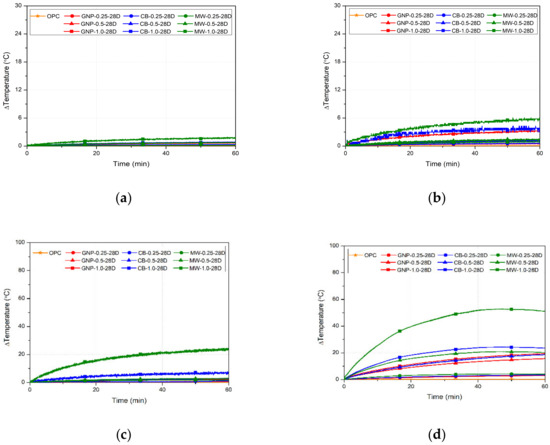
Figure 5.
Temperature variation plots of the nanocementitious composites at 28 d at different voltages: (a) 10 V; (b) 20 V; (c) 30 V; (d) 60 V.
The heating performance of the MWCNT-mixed cementitious composite was found to be the most outstanding, regardless of the curing days. The heating performance of the nanocementitious composites cured for 28 d was improved further as the concentration of mixed nanomaterials and the supply voltage increased, similar to that obtained after 7 d of curing. When the same type of nanomaterial was mixed in cementitious composites, the heating value increased as the mixed concentration of nanomaterials increased. The heating performance of the nanocementitious composites cured for 28 d degraded overall compared with the nanocementitious composites cured for 7 d. When the heating performances of all carbon-based nanomaterials were compared as a function of the curing days, the specimens after 28 d of curing were up to 14.7 °C, 27.4 °C, and 20.4 °C lower than those of the specimens after 7 d of curing for MWCNT, CB, and GNP, respectively. Owing to the effects of moisture during the early phases of curing, the cementitious composite cured for 7 d decreased the electrical resistance, and thus yielded higher temperature variations than the cementitious composite cured for 28 d. The heating performances of the mixed nanomaterials were the highest at 19.6 °C, 24.3 °C, and 52.8 °C in the cases of GNP-, CB-, and MWCNT-mixed cementitious composites, respectively. In the case of curing for 7 d, the hydration reaction did not proceed completely. However, given that the hydration reaction was completed on the 28 d of curing, a different heating performance appeared. Therefore, the most outstanding heating performance in the nanocementitious composite at 28 d of curing was observed in the case of the MWCNT cementitious composite, similar to the nanocementitious composite cured for 7 d followed by the CB and GNP cementitious composites.
Figure 6, Figure 7 and Figure 8 show the thermal images of nanocementitious composites with 0.25 wt%, 0.5 wt%, 1.0 wt% mixed concentration of each nanomaterial at a supply voltage of 60 V. The thermal images of cementitious composites were taken when temperature graph was highest point. According to the analysis of the thermal images, MWCNT-cementitious composite demonstrated the most outstanding heating performance and exhibited the largest area of heat generated from the steel mesh. While the CB cementitious composite yielded a lower temperature than that of the MWCNT cementitious composite, heat was evenly distributed throughout the cementitious composite. The GNP cementitious composite yielded a relatively lower heating performance than those of the MWCNT and CB cementitious composites. OPC demonstrated a significantly lower heating performance overall, and no significant difference was observed from the surrounding temperature in the thermal images. Additionally, the analysis of the thermal images showed that the MWCNT cementitious composite exhibited the best heat dissipation, which was almost verified in the heating performance experiment.
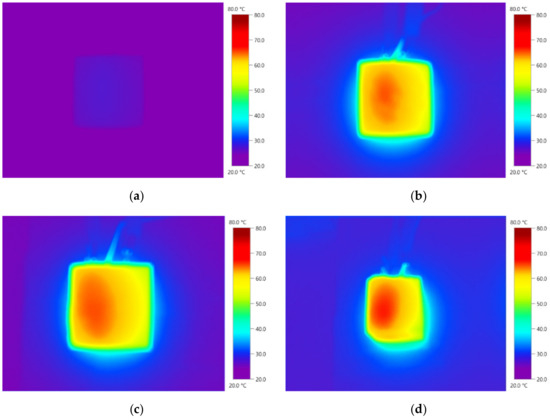
Figure 6.
Thermal images of the nanocementitious composites with 0.25 wt% (60 V): (a) OPC; (b) GNP-0.25; (c) CB-0.25; (d) MW-0.25.
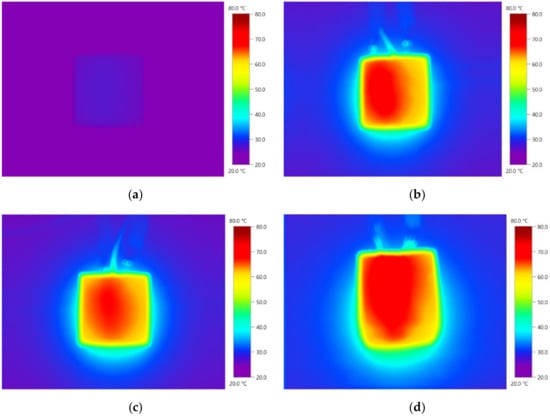
Figure 7.
Thermal images of the nanocementitious composites with 0.5 wt% (60 V): (a) OPC; (b) GNP-0.5; (c) CB-0.5; (d) MW-0.5.
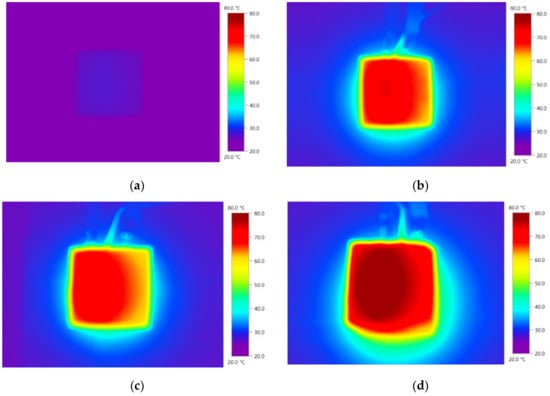
Figure 8.
Thermal images of the nanocementitious composites with 1.0 wt% (60 V): (a) OPC; (b) GNP-1.0; (c) CB-1.0; (d) MW-1.0.
Figure 9 shows the electrical resistance values of the nanocementitious composites cured for 28 d. When the electrical resistances of the cementitious composites GNP, CB, and MWCNT were compared with that of OPC, the electrical resistance of OPC was the highest at 50,549 Ω. The electrical resistances of the GNP, CB, and MWCNT cementitious composites with 1.0 wt% were 24,917 Ω, 22,161 Ω, and 384 Ω, respectively, which shows that the electrical resistance value decreased in the order of OPC, GNP, CB, and MWCNT. Considering that the electrical conductivity in inversely proportional to electrical resistance, OPC, which had the largest electrical resistance, exhibited the smallest electrical conductivity and the lowest heating performance. By contrast, the MWCNT cementitious composite with the smallest electrical resistance exhibited the highest electrical conductivity, and hence, exhibited the best heating performance.
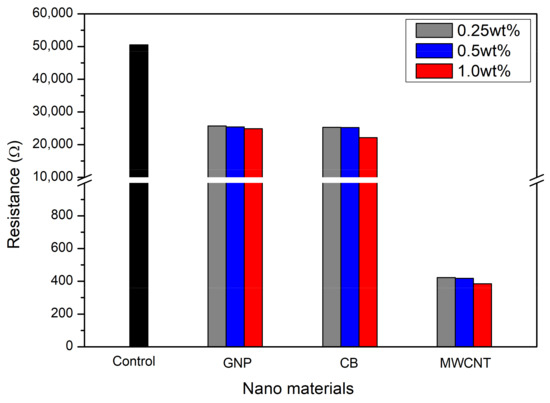
Figure 9.
Resistance of the nanocementitious composites.
In this study, SEM was used to acquire images of certain components collected from the cementitious composites, which comprised a mixture of three nanomaterials. Figure 10 shows the internal microstructure of nanocementitious composites captured by irradiating accelerated electron beams onto the specimens. When the microstructure of each specimen was analyzed, calcium silicate hydrate (C–S–H) was mostly observed in OPC. The GNP-cementitious composite had plate-shaped GNP aggregates, whereas the CB cementitious composite did not contain CB aggregates given that the particles were not uniformly distributed. The MWCNT cementitious composite had a network formed given that CNT particles were uniformly distributed between cement hydrates. Based on FE-SEM images, this study discovered that the MWCNT cementitious composite exhibited the best dispersibility; hence, the heating and electrical performances of the MWCNT cementitious composites were outstanding.
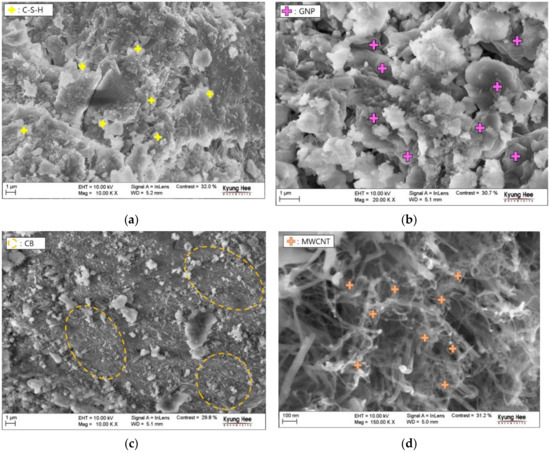
Figure 10.
Field-emission scanning electron microscopy images: (a) OPC; (b) GNP-1.0; (c) CB-1.0; (d) MW-1.0.
4. Conclusions
In this study, carbon-based nanomaterials were mixed with cementitious composites to measure their heating performances and electrical resistances based on various parameters, such as the type, curing days, and mixed concentration. The following conclusions were deduced:
- Among the three types of carbon-based nanomaterials, MWCNT demonstrated the best heating performance when mixed with cementitious composites. The heating performance according to the mixed nanomaterials showed that the GNP cementitious composites yielded the highest temperature of 40 °C, whereas the CBs and MWCNT cementitious composites yielded the values of 51.7 °C and 67.5 °C, respectively. Hence, MW-1.0-7D recorded a temperature up to 224 times higher than OPC. Based on the temperature variations of carbon-based nanomaterials, the heating performance was outstanding in the following order: MWCNT > CB > GNP. This indicates that the networks between nanomaterials were formed most noticeably in the case of the MWCNT cementitious composites that resulted in an outstanding heating performance.
- The heating performances of cementitious composites mixed with carbon-based nanomaterials decreased as the curing days increased. The largest temperature variation was exhibited between CB-1.0-7D and CB-1.0-28D (51.7 °C to 24.3 °C), which corresponded to a decrease of 27.4 °C. Furthermore, the heating performances of cementitious composites decreased as the curing days increased owing to the diminished effect of moisture within cementitious composites.
- The heating performance was further improved as the mixed concentration of nanomaterials increased. The highest temperature was recorded when the nanomaterial was mixed with 1.0 wt% with respect to the cement weight. The temperature was up to 132 times, 171 times, and 263 times higher in GNP, CB, and MWCNT cementitious composites, respectively, compared with the outcomes obtained for a mixed concentration of 0.0 wt%. The thermal conductivity increased as more networks formed, as the mixed concentration of nanomaterials increased.
- When the electrical resistances of GNP, CB, and MWCNT cementitious composites were compared with that of OPC, the electrical resistance of OPC without nanomaterials was the highest at 50,549 Ω. Furthermore, GNP recorded the second highest electrical resistance value after OPC, followed by CB and MWCNT, respectively. The MWCNT cementitious composite demonstrated the most outstanding performance in terms of electrical conductivity based on the electrical resistance experiment when compared with the heating experiment. Therefore, mixing MWCNT in cementitious composites is considered most appropriate for preventing black ice on roads.
Author Contributions
H.L.: Writing—Reviewing and Editing, Conceptualization, Project administration. S.P.: Formal analysis, D.K.: Data curation, Investigation. W.C.: Writing—Original draft preparation, Writing—Reviewing and Editing. All authors have read and agreed to the published version of the manuscript.
Funding
This study was supported by a research fund from Chosun University, 2020.
Data Availability Statement
Not applicable.
Acknowledgments
This study was supported by a research fund from Chosun University, 2020.
Conflicts of Interest
The authors declare no conflict of interest.
References and Note
- Zhang, Q.; Li, H. Experimental Investigation on the Ice/Snow Melting Performance of CNFP & MWCNT/Cement-based Deicing System. In Proceedings of the 6th International Workshop on Advanced Smart Materials and Smart Structures Technology, Dalian, China, 25–26 July 2011. [Google Scholar]
- Lee, H.; Jeong, S.; Park, S.; Chung, W. Enhanced mechanical and heating performance of multi-walled carbon nanotube-cement composites fabricated using different mixing methods. Compos. Struct. 2019, 225, 111072. [Google Scholar] [CrossRef]
- Lee, H.; Yu, W.; Loh, K.J.; Chung, W. Self-heating and electrical performance of carbon nanotube-enhanced cement composites. Constr. Build Mater. 2020, 250, 118838. [Google Scholar] [CrossRef]
- Haider, M.Z.; Jin, X.; Sharma, R.; Pei, J.; Hu, J.W. Enhancing the compressive strength of thermal energy storage concrete containing a low-temperature phase change material using silica fume and multiwalled carbon nanotubes. Construction and Build Mater. 2022, 314, 125659. [Google Scholar] [CrossRef]
- Liu, Y.; Lai, Y.; Ma, D.X. Research of carbon fibre grille reinforced composites in airport pavement snowmelt. Mater. Res. Innov. 2015, 19 (Suppl. 10), S10–S49. [Google Scholar] [CrossRef]
- Won, J.P.; Kim, C.K.; Lee, S.J.; Lee, J.H.; Kim, R.W. Thermal characteristics of a conductive cement-based composite for a snow-melting heated pavement system. Compos. Struct. 2014, 118, 106–111. [Google Scholar] [CrossRef]
- Lee, H.; Song, Y.M.; Loh, K.J.; Chung, W. Thermal response characterization and comparison of carbon nanotube-enhanced cementitious composites. Compos. Struct. 2018, 202, 1042–1050. [Google Scholar] [CrossRef] [Green Version]
- Lee, H.; Park, S.; Cho, S.; Chung, W. Correlation analysis of heating performance and electrical energy of multi-walled carbon nanotubes cementitious composites at sub-zero temperatures. Compos. Struct. 2020, 238, 111977. [Google Scholar] [CrossRef]
- Jung, M.; Lee, Y.S.; Hong, S.G.; Moon, J. Carbon nanotubes (CNTs) in ultra-high performance concrete (UHPC): Dispersion, mechanical properties, and electromagnetic interference (EMI) shielding effectiveness (SE). Cem. Concr. Res. 2020, 131, 106017. [Google Scholar] [CrossRef]
- Makar, J.; Margeson, J.; Luh, J. Carbon Nanotube/Cement Composites-early Results and Potential Applications. In Proceedings of the 3rd International Conference on Construction Materials: Performance, Proceedings of the 3rd International Conference on Construction Materials: Performance, Innovations and Structural Implications, Vancouver, BC, Canada, 21 August 2005; Springer: Cham, Switzerland, 2021; pp. 1–10. [Google Scholar]
- Kim, G.M.; Naeem, F.; Kim, H.K.; Lee, H.K. Heating and heat-dependent mechanical characteristics of CNT-embedded cementitious composites. Compos. Struct. 2016, 136, 162–170. [Google Scholar] [CrossRef]
- Lee, H.; Seong, J.; Chung, W. Correlation analysis of heat curing and compressive strength of carbon nanotube–cement mortar composites at sub-zero temperatures. Crystals 2021, 11, 1182. [Google Scholar] [CrossRef]
- Manzur, T.; Yazdani, N.; Emon, M.; Bashar, A. Effect of carbon nanotube size on compressive strengths of nanotube reinforced cementitious composites. J. Mater. 2014, 2014, 1–8. [Google Scholar] [CrossRef]
- Kim, G.M.; Yang, B.J.; Cho, K.J.; Kim, E.M.; Lee, H.K. Influences of CNT dispersion and pore characteristics on the electrical performance of cementitious composites. Compos. Struct. 2017, 164, 32–42. [Google Scholar] [CrossRef]
- Li, G.Y.; Wang, P.M.; Zhao, X. Mechanical behavior and microstructure of cement composites incorporating surface-treated multi-walled carbon nanotubes. Carbon 2005, 43, 1239–1245. [Google Scholar] [CrossRef]
- Xu, S.; Liu, J.; Li, Q. Mechanical properties and microstructure of multi-walled carbon nanotube-reinforced cement paste. Constr Build Mater. 2015, 76, 16–23. [Google Scholar] [CrossRef]
- Monteiro, A.O.; Cachim, P.B.; Costa, P.M.F.J. Electrical properties of cement-based composites containing carbon black particles. Mater. Today Proc. 2015, 2, 193–199. [Google Scholar] [CrossRef]
- Li, H.; Xiao, H.G.; Ou, J.P. Effect of compressive strain on electrical resistivity of carbon black-filled cement-based composites. Cem. Concr. Res. 2006, 28, 824–828. [Google Scholar] [CrossRef]
- A.O. Monteiro et al. studied the electrical and mechanical properties of a cement-based composite, containing different amounts of CB and its response when subjected to a compressive load. Increments of compressive strengths were seen for the mortar sample containing 4% volume of aggregates of CB compared to the sample without carbon.
- Ding, Y.; Chen, Z.; Han, Z.; Zhang, Y.; Pacheco-Torgal, F. Nano-carbon black and carbon fiber as conductive materials for the diagnosing of the damage of concrete beam. Constr. Build Mater. 2013, 43, 233–241. [Google Scholar] [CrossRef] [Green Version]
- Farooq, F.; Rahman, S.K.U.; Akbar, A.; Khushnood, R.A.; Javed, M.F. A comparative study on performance evaluation of hybrid GNPs/CNTs in conventional and self-compacting mortar. Alex Eng. J. 2020, 59, 369–379. [Google Scholar] [CrossRef]
- Tao, J.; Wang, J.; Zeng, Q. A comparative study on the influences of CNT and GNP on the piezoresistivity of cement composites. Mater. Lett. 2020, 259, 126858. [Google Scholar] [CrossRef]
- Le, J.L.; Du, H.; Dai Pang, S. Use of 2D graphene nanoplatelets (GNP) in cement composites for structural health evaluation. Compos. B Eng. 2014, 67, 555–563. [Google Scholar] [CrossRef]
- Sedaghat, A.; Ram, M.K.; Zayed, A.; Kamal, R.; Shanahan, N. Investigation of physical properties of graphene-cement composite for structural applications. Open. J. Compos. Mater. 2014, 4, 41685. [Google Scholar] [CrossRef] [Green Version]
- Silva, R.A.; de Castro Guetti, P.; da Luz, M.S.; Rouxinol, F.; Gelamo, R.V. Enhanced properties of cement mortars with multilayer graphene nanoparticles. Constr. Build. Mater. 2017, 149, 378–385. [Google Scholar] [CrossRef]
- Wang, B.; Jiang, R.; Wu, Z. Investigation of the mechanical properties and microstructure of graphene nanoplatelet-cement composite. Nanomaterials 2016, 6, 200. [Google Scholar] [CrossRef]
- ASTM C109/C109M-20b; Standard Test Method for Compressive Strength of Hydraulic Cement Mortars (Using 2-in. or [50 mm] Cube Specimens). ASTM International: West Conshohocken, PA, USA, 2020.
- Korean Standard KS L ISO 679; Methods of Testing Cements–Determination of Strength. Korean Agency for Technology and Standards (KATs): Seoul, Republic of Korea, 2006.
- ISO 679; Cement–Test methods–Determination of Strength. International Organization for Standardization: Geneva, Switzerland, 2009.
- Lee, H.; Park, S.; Park, S.; Chung, W. Enhanced detection systems of filling rates using carbon nanotube cement grout. Nanomaterials 2020, 10, 10. [Google Scholar] [CrossRef] [Green Version]
Publisher’s Note: MDPI stays neutral with regard to jurisdictional claims in published maps and institutional affiliations. |
© 2022 by the authors. Licensee MDPI, Basel, Switzerland. This article is an open access article distributed under the terms and conditions of the Creative Commons Attribution (CC BY) license (https://creativecommons.org/licenses/by/4.0/).